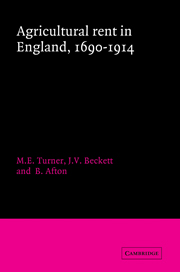Book contents
- Frontmatter
- Contents
- List of figures
- List of tables
- Preface
- Note on the text
- List of abbreviations
- Two examples of contemporary rent books
- Introduction
- 1 Agricultural rent in England
- 2 Contemporary views of rent in eighteenth and nineteenth-century England
- 3 The current state of knowledge
- 4 The determining parameters of a rent index
- 5 Constructing the rent index I: estate records
- 6 Constructing the rent index II: government inquiries
- 7 Constructing the rent index III: other studies
- 8 An English agricultural rent index, 1690–1914
- 9 Rent arrears and regional variations
- 10 The rent index and agricultural history I: the long term
- 11 The rent index and agricultural history II: the short term
- Conclusion
- Appendix 1 Sources of the rent index
- Appendix 2 Statistical summary
- Bibliography
- Index
Appendix 1 - Sources of the rent index
Published online by Cambridge University Press: 02 December 2009
- Frontmatter
- Contents
- List of figures
- List of tables
- Preface
- Note on the text
- List of abbreviations
- Two examples of contemporary rent books
- Introduction
- 1 Agricultural rent in England
- 2 Contemporary views of rent in eighteenth and nineteenth-century England
- 3 The current state of knowledge
- 4 The determining parameters of a rent index
- 5 Constructing the rent index I: estate records
- 6 Constructing the rent index II: government inquiries
- 7 Constructing the rent index III: other studies
- 8 An English agricultural rent index, 1690–1914
- 9 Rent arrears and regional variations
- 10 The rent index and agricultural history I: the long term
- 11 The rent index and agricultural history II: the short term
- Conclusion
- Appendix 1 Sources of the rent index
- Appendix 2 Statistical summary
- Bibliography
- Index
Summary
This appendix sets out the sources from which the rent index was compiled, and establishes for the three source provenances the relative proportions of the materials involved. Part I lists the archival sources from which the data was collected; part II lists material which was originally published in the Minutes of Evidence attached to the Royal Commission on Agriculture, 1894–6, and has now been extracted for inclusion in the index; part III lists material collected and collated by other historians in books, articles, and unpublished theses, which have been used in the index; and part IV shows the relative proportion of data from these three sources which make up the index.
The material is named and then listed alphabetically, but the manner of choosing an appropriate name is not regular. In part I the institutional estates – Emanuel and Greenwich hospitals – are listed under their institutional names, but the remainder are listed in the same manner as they have been accessioned in the archives. Usually this means the names registered and by which the individual estates are known, or by which the different collections of large, widely scattered estates, are known. Thus the largest and most famous of the private estates such as Badminton (Duke of Beaufort), Chatsworth (Duke of Devonshire), Holkham (Earl of Leicester), and Tavistock (Duke of Bedford), have been listed alphabetically under those well-known names. They also indicate broad geographical location.
The material collected by the Royal Commission on Agriculture in the 1890s has been collated in part II under two separate lists.
- Type
- Chapter
- Information
- Agricultural Rent in England, 1690–1914 , pp. 258 - 307Publisher: Cambridge University PressPrint publication year: 1997

